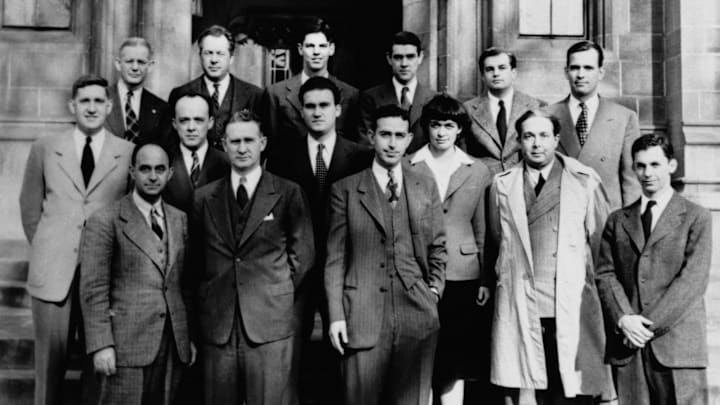“Now I am become Death, the destroyer of worlds,” physicist J. Robert Oppenheimer said to himself as he watched the first-ever nuclear mushroom cloud form over the Jornada del Muerto desert in New Mexico. The famous quote, borrowed from an ancient Hindu scripture known as the Bhagavad-Gita, raises an important but often overlooked question: why did Oppenheimer and his colleagues agree to create a weapon that, in addition to killing hundreds of thousands of Japanese citizens, could one day end all life on Earth?
Of the estimated 130,000 people who participated in the Manhattan Project, the vast majority had no idea what exactly they were building. Like assembly line workers, they performed their small, specialized tasks without ever being shown the bigger picture. Those who did see it had their reasons for staying on board. Some wanted money: the project’s wages were reportedly better than average. Others acted out of patriotism, seeking revenge for the lives lost at Pearl Harbor. Others still were motivated by scientific curiosity. “We’re working on something that’s more important than the discovery of electricity,” chemist Glenn Seaborg, who headed the plutonium division, told his recruits. “This almost always brought them in.”
Emphasis on “almost” as, for a small number of scientists, these promises of fame and fortune were not worth their moral cost. “I will have nothing to do with a bomb!” Lise Meitner, an Austrian physicist credited with the discovery of nuclear fission, responded when she was approached to join the Manhattan Project. Meitner was accompanied by the Italian physicist Franco Rasetti, a longtime collaborator with Enrico Fermi, as well as Noble Prize-winner Isidor Rabi. Rabi refused an offer from Oppenheimer to become deputy director of the entire project, serving only in limited capacity as a consultant.
Some scientists joined the Manhattan Project only to oppose it down the line when they came to grasp its destructive potential. Polish-British physicist Joseph Rotblat arrived at the laboratory at Los Alamos in 1944 to head its theoretical division, but left later that year when scientists learned that Nazi Germany was nowhere close to developing an atomic bomb of its own. (Countering the Nazis’ potential atomic arsenal had been an original purpose of the Manhattan Project.) Long accused of Soviet espionage, Rotblat was not allowed back into the U.S. until 1964. Such accusations did not stop his anti-nuclear crusade, however, and in 1993 he published a book arguing in favor of dismantling every weapon of mass destruction on the planet.

Another scientist who came to regret his time at Los Alamos was Leo Szilard. The Hungarian-American physicist had been one of the people who, alongside Albert Einstein, had helped get the Manhattan Project off the ground. In 1945, he went from department to department collecting signatures for a petition to dissuade President Harry Truman from dropping their terrible creations onto Hiroshima and Nagasaki. The petition, signed by more than 70 experts, argued that, while the Second World War needed to be “brought speedily to a successful conclusion,” any attack on Japan could not be justified until the country had been given an opportunity to surrender. More importantly, perhaps, the petitioners felt that the U.S., as the first country to possess nuclear weapons, should set an example for the rest of the world by refraining from using them:
“The development of atomic power will provide the nations with new means of destruction. The atomic bombs at our disposal represent only the first step in this direction, and there is almost no limit to the destructive power which will become available in the course of their future development. Thus a nation which sets the precedent of using these newly liberated forces of nature for purposes of destruction may have to bear the responsibility of opening the door to an era of devastation on an unimaginable scale.”
With his petition, Szilard antagonized the federal government, the military, and Oppenheimer, who made sure none of the scientists stationed at the Los Alamos lab was given a chance to sign the document. Oppenheimer believed there was no point to developing something that was never going to be tested. “If you are a scientist you cannot stop such a thing,” he said during his farewell speech in 1945. “If you are a scientist you believe that it is good to find out how the world works; that it is good to find out what the realities are; that it is good to turn over to mankind at large the greatest possible power to control the world and to deal with it according to its lights and its values.”
Oppenheimer did experience a change of heart later in life, when he came to oppose the advent of hydrogen bombs on grounds that they were even more destructive than their atomic counterparts. But his pleas, like those of his colleagues before him, came too late. Rotblat never convinced world leaders to agree to a global nuclear disarmament. Szilard’s petition never reached Truman—incoming Secretary of State James F. Byrnes had declined to show it to him. And Hiroshima and Nagasaki were engulfed in smoke and radiation.
